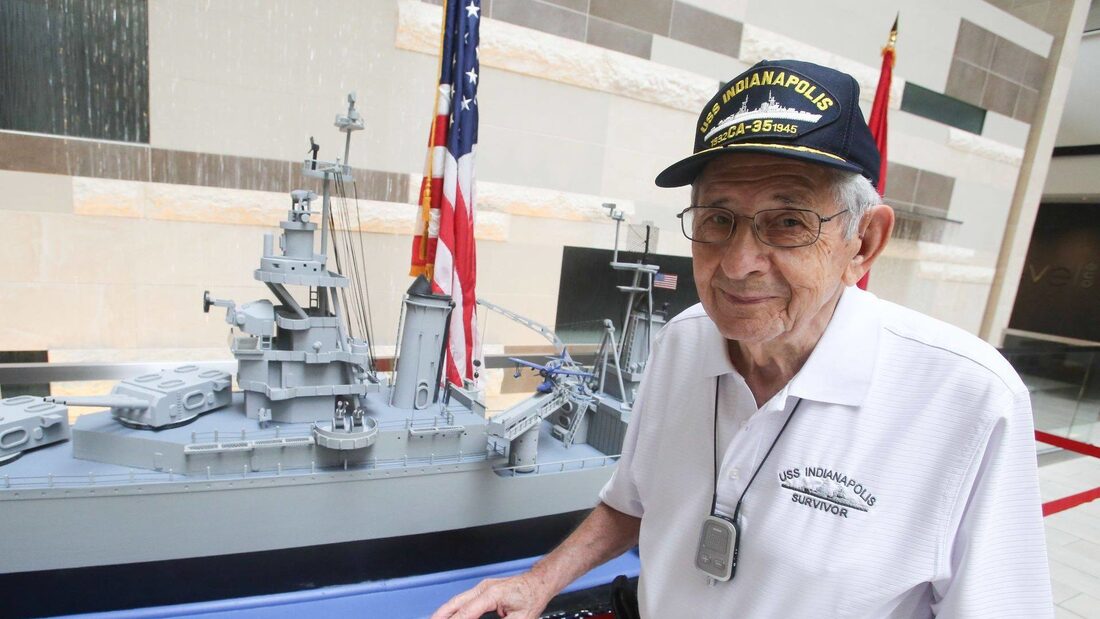|
By: Kathy Kent Toney, CEO & Founder of Kent Business Solutions Last year I watched a Lessons in Leadership, courtesy of Randy Powell when he interviewed WWII Veteran Edgar Harrell. For those of you who are not familiar with Sgt. Edgar Harrell, he was the last remaining Marine survivor of the USS Indianapolis tragedy. I say "was" because he passed away on May 8, 2021, not too long after Randy interviewed him. With Memorial Day upon us, I'd love to share with you his riveting story. For those not familiar with what happened to the USS Indianapolis, or if you'd like a refresher, here's a description from Sgt. Harrell's website: On July 16, 1945, the USS Indianapolis departed from San Francisco for the American B-29 base on Tinian island with a top-secret cargo that would ultimately put an end to World War II—components for the first operational atomic bombs. After a record run, covering 5,300 miles in only ten days, the Indianapolis successfully delivered her cargo on July 26, 1945, and was ordered to set a course from Guam to the Leyte Gulf in the Philippines to prepare for the invasion of Japan. Traveling unescorted, at fourteen minutes past midnight on July 30, 1945, she was hit by two Japanese torpedoes midway between Guam and Leyte, sending her to a watery grave in twelve minutes. Of the 1,196 men aboard, about 900 sailors and Marines entered the water. Due to a series of Navy debacles, no one knew of their plight. Five horrifying days later, 317 men who had survived the terror of shark attacks, hypothermia, severe dehydration and salt-water hallucinations, were accidentally spotted and rescued. [For those who want to hear his story first-hand, here's a condensed version of the full-length video.] Sgt. Harrell’s courage, valor, and never-give-up attitude is so inspiring. It got me thinking--what were the things he did that saw him through? Here are what I see as firm choices he made to survive those 4 ½ days afloat in the ocean:
I believe Sgt. Harrell's account can be a true source of inspiration for all of us. During this strange season, so many feel like we're hanging on for dear life, wondering if we'll make it through these challenging times. Here are a couple of thoughts along these lines: When we make decisions during tough times, like Sgt. Harrell did, to persevere, have faith and hope, and help others along the way, we'll have more grit to make it through--not only to survive but to thrive. If we can carry this never-give-up mindset going during these challenging times we're in, we'll more clearly see endless opportunities and good things to come, no matter how bad things look. # # # Speaking of challenging times, how is your business doing these days? Could you use an outside perspective to shed some light on your current circumstances? If that's you, I'd love to have a chat! If I can't help you in a particular area, I have a whole team of alliance partners with over 300 years of executive experience that can provide for any need you may have. Click the button below to set up a quick chat!
0 Comments
By: Kathy Kent Toney, CEO & Founder of Kent Business Solutions I remember when I was a new employee starting in the corporate world. I was a newbie in so many ways! I didn't know the political landscape of what to do and not to do, and I didn’t see the value in establishing relationships with my colleagues. So, I’d do my job, eat lunch at my desk, and didn’t go for happy hours with my co-workers. I missed out on a lot at the beginning of my career! Now I understand the value of how important it is to build meaningful relationships with co-workers. Doing so creates a foundation for winning teams. According to a Gallup poll, organizations with good employee engagement have 41% fewer quality defects, 37% less absenteeism, and a 21% increase in productivity. So, what are some key things you can do to improve your relationships with your colleagues and those you lead? Here are some practical tips: 1. Be Intentional About Developing Relationships Investing in meaningful relationships can be game-changing for you and those you connect with. Develop an inner circle of trusted peers with whom you can freely share what's going on with your employees or, if appropriate, even your personal life. Make time in your calendar to meet with your team, peers, and others with whom you can mutually benefit each other. 2. Regularly Express Appreciation and Encouragement Give kudos to employees who go above and beyond what you expect from them. Send them thank-you notes and let others on the team know about their excellent performance. Also, keep an eye out for those employees who show potential but haven't stepped into that potential yet. Let them know you see that potential in them and call it forth. You may find your next star employee by doing so! 3. Be More Accepting of Your Team Members and Colleagues Leaders and managers who accept their employees for who they are can reap so many benefits. When employees feel accepted, they feel freer to be themselves. When that happens, the synergy of acceptance among team members can improve teamwork and productivity. Also, practice accepting your employees, peers, and colleagues, even if they irritate you. It's possible that your source of irritation could be something you don't like about yourself that you see in them. A great practice is to embrace those similar quirks you have, which can help you be more accepting of others. Did you like this blog? If so, check back during the coming weeks. I plan to share 7 Essential Skills for Leaders to Embrace. This blog on Relationship Building is the first of seven. I'll also cover topics such as Resilence, Conflict Management, and Stepping Out of Your Comfort Zone. So stay tuned! # # # Speaking of building great relationships, would you like some ideas on how to engage your remote work teams more effectively? Then download my FREE list of ideas on how to do just that. You'll find some tips and suggestions for fun activities to ensure your remote workers feel connected. Click the button below to get started!
By: Kathy Kent Toney, CEO & Founder of Kent Business Solutions The word savviness isn’t used too frequently, but it’s a word that's rich with significance. It means "shrewdness and practical knowledge; the ability to make good judgments." It’s a quality that good leaders would do well to embrace. You combine that with "leadership," and that's a winning combo! So, what does it take to increase your leadership savviness? Here are five steps for raising your quotient: 1. Read, Read, Read We've all heard how important it is for business leaders to read regularly. Business icons like Mark Cuban read three hours a day, and Warren Buffet reads 500 pages per day! There are always audio books, YouTube, and even online classes you can take for those who don't like to read. The point is this: it keeps important concepts top of mind. Not only that, but here are a few other benefits:
And don’t we all need less stress in our lives! 2. Listen and Observe Intently Become a student of leaders you admire through critical listening and observation. Doing so can teach you a wealth of information. This approach works well with excellent leaders you admire and with whom you're personally acquainted. Even informal conversations with them can give you many nuggets of wisdom you can use in your everyday work lives. Also, observing how they lead can give you ideas of ways to emulate them. 3. Learn from Your Mistakes Many wannabe leaders hate making mistakes and don't take risks, limiting their ability to step into more responsible roles. On the other hand, great leaders know that making mistakes and learning from them is part of the process. It's a part of their course of development, though certainly, not intentionally. My advice to you is this: don't be afraid of making mistakes! Most managers are tolerant and understanding when you do, especially if you let them know you want to grow in taking risks. 4. Work with Mentors Great leaders became that way through mentors passing on their knowledge to them. I say "mentors" because having more than one is better than just one. If you don’t have any, start asking leaders you admire to mentor you, even if you think they might be too busy. You may be pleasantly surprised when they say "yes"! 5. Practice What You’ve Learned Put into action all that you’ve learned. If you’re working with a mentor, develop an action plan and review progress during your follow-on meetings. Continually update your plan based on achieving your goals and new areas you want to grow in. And stick to it. Growing into a great leader requires due diligence and intentional effort. These are just a few steps you can take to increase your leadership savviness. The key is to be open to learning from everyday experiences and from leaders you admire. # # # Speaking of leadership, I have a LinkedIn newsletter I produce weekly called Leading Well. It's chock full of leadership tips and even an occasional piece on Digital Transformation. If you’re not already subscribed, here’s your opportunity to do that now! Click the button below to get started!
By: Kathy Kent Toney, CEO & Founder of Kent Business Solutions Did you know that you can use your imperfections as a superpower? I was talking a while back with my strategic partner, Michael Cantu, about a subject we covered in our soon-to-be-published paperback on digital transformation: the power of celebrating our quirks and shortcomings. It’s a key element to building the right culture and teams supporting digital transformation. It inspired me so much that I just had to share it with you! Ever since Michael was a little kid, he’s experienced shaky hands. It’s not because he’s nervous…it just happens naturally. So, when he was a kid coming into a new classroom, he would let other kids know about his quirk, something like this: "Just to let you know, I have shaky hands. I’m not nervous; they just shake." What a great way to help his classmates deal with what could be an uncomfortable situation! Now he uses it as a superpower in business…when he’s giving presentations, he jokes about his shaky hands with everyone, telling them they’ll never be able to know if he’s nervous because he’s shaking all the time. That’s how he hides any potential nervousness because they’ll never know if he is or not. And he’s applied this philosophy to creating great cultures in organizations and building rock star teams…all through making it a norm to accept people’s differences. So, here are some lessons learned along these lines, inspired by his story: 1. Embrace Our Quirks Michael didn’t see his shaky hands as a big issue as a kid. He accepted the fact and decided to deal with it in positive ways. Lessons Learned: so many of us don’t like our weaknesses. We think it’s something we have to hide or minimize, perhaps because it points out the possibility that there’s something wrong with us. But some of the most outstanding leaders I know humbly acknowledge their weaknesses. 2. Be Yourself, With No Excuses Because Michael accepted his situation, there was no reason for him to make any excuses. Instead, he chose to highlight, in a unique way, what made him different from everyone else so that he could put others at ease. Lessons Learned: There’s such strength in being ourselves. If we can learn to celebrate our weaknesses on a regular basis, that lessens our striving to be something we’re not. Just being who we make it that much easier for others to interact with us, and as a leader, that much easier to follow. 3. Use Our Quirks as a Superpower Michael’s ability to accept his quirks has been key to building two successful companies and putting together high-performing teams for his clients. Lessons Learned: when we can embrace our weaknesses, that gives us the ability to accept and celebrate others’ weaknesses. This, in turn, creates an environment where team members and employees feel free to be themselves. When that happens, the sky limits what teams and companies can accomplish! I hope Michael’s story inspires you as much as it did me! I hope you can practice some of these tips to help you in your leadership journey. # # # About the paperback, I mentioned earlier…Michael and I hope to have it published soon! Last fall, we published the e-book with great results—it was the #1 New Release in IT on Amazon. We’re excited! If you’d like to learn more about the e-book, click on the button below to check it out.
By: Kathy Kent Toney, CEO & Founder of Kent Business Solutions Famous leaders with excellent track records have so much wisdom to share with us; however, finding time to read a book can be a challenge for busy professionals. Thankfully, we can quickly learn a few things through leadership quotes. Here are a few that recently caught my eye: 1. A man who wants to lead the orchestra must turn his back on the crowd. – Max Lucado How many of us cave into the negative criticism of others when we know the path we want to take? Turning our backside to the naysayers, when you know the right direction to take, is often the best thing to do. 2. Become the kind of leader that people would follow voluntarily, even if you had no title or position. – Brian Tracy I'm sure many of you have worked with exceptional leaders that you were eager to follow for many reasons. Perhaps they were fun to work with, or they brought out the best in you, and therefore you were willing to give your best to them. A great exercise is to keep that person in mind as you go about being a leader. Then exemplify those traits you admire in them as your lead others. 3. Treat people as if they were what they ought to be, and you help them become what they are capable of being. – Johann Wolfgang Von Goethe One of the best managers I ever worked for called out leadership abilities that I didn't know existed. He then put me in positions where I had the chance to practice those abilities. What he did helped me to grow by leaps and bounds! 4. The leader's task is to get their people from where they are to where they have not been. – Henry Kissinger This idea is closely related to #3. If it hadn't been for this one manager who had not invested in me, I would not be the leader I am today, for which I'm so grateful! With that in mind, here's a tip you can try: think about each of your team members, the hidden abilities that they have. Then do what my boss did with me for some or each of them. It works; I'm living proof! 5. The greatest leader is not necessarily the one who does the greatest things. He is the one who gets the people to do the greatest things. – Ronald Reagan Great leaders do an excellent job of empowering team members to be the best they can be through modeling many of these characteristics outlined above. They also create an environment where employees become enthusiastic about their work, collaborate well, and in the end, accomplish exceptional results. # # # Speaking of leading well, I have a LinkedIn newsletter I produce weekly called Leading Well. If you’re not already subscribed, here’s your opportunity to do that now! Click the button below to get started!
|
Archives
July 2024
Categories
All
|










 RSS Feed
RSS Feed
